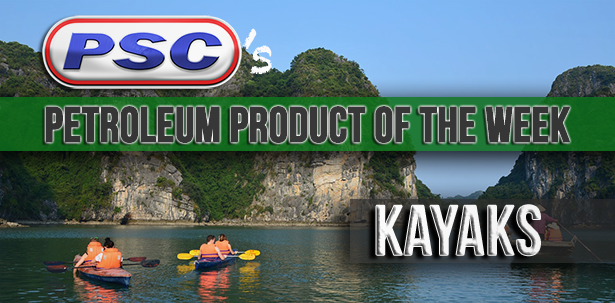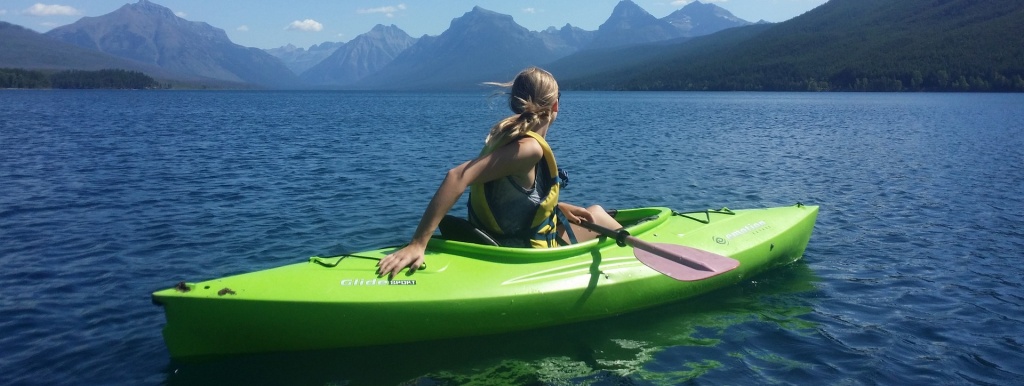Petroleum Product of the Week: Kayaks
By on Aug 11 2017

One of my favorite things to do this time of year is get out on a kayak and spend some time on the river.
Kayaking has only been a part of my life for the past year or so, but I've become extremely passionate about it. I bought a roof rack and everything so I can take my kayak anywhere I want and see new places.
This recreational use wasn't always the life of a kayaker. These floating, plastic wonders were once made from wood and used for hunting purposes. And they were built tough.
While the materials have changed, they're made tough today, too. Most plastic kayaks are made from polyethylene (more on that later), which is longer-lasting compared to the alternate, fiberglass.
History and Evolution of Kayaking Materials
It wasn't until the 1800s that kayaks were used for recreation and sport. Today, most kayaks are made from fiberglass or plastic, though you can still purchase kayaks made from wood that more closely reflects original kayak designs.

Prior to that, it's believed that the first kayaks were used 2,000 years ago by Eskimos for transportation and hunting/fishing. These weighed about 26 pounds and measured up to 20 feet long.
Made from bone or driftwood, Eskimos secured the frames together with seal sinew or gut, then covered it with caribou skins and waterproofed the kayak with natural materials.
Europeans started using kayaks in 900 A.D. and the Germans invented a collapsible kayak made from rubberized canvas that could easily be transported over land.
Wooden kayaks often use a waterproof glue to secure the pieces together and ensure that the boats stay afloat. They are also often covered with fabric that is treated with a further waterproofing substance, such as a plasticised lacquer or an exterior paint.
In the 1950s, kayaks were revolutionized with a modeling practice. Rather than building a frame, two-piece molds were used. This method was revolutionized in the 1980s with the use of polyethylene and recycled plastics. This is really where the petroleum comes into the picture.
How It's Made: Polyethylene and Molds
About 80 million tons of polyethylene are used each year. From plastic bags to kayaks, it's the most used form of plastic. It is also a very durable material, which is what makes it so great for kayaks.
There are a few different methods used that transform the polyethylene, and most use a mold to form the boat.
Roto-molding creates a seamless kayak, which tends to be more expensive because they typically last longer. A large mold is filled with powdered plastic, which is put into an oven. The oven melts the powdered plastic into a liquid. It is then cooled into the final product: a seamless kayak.
These seamless kayaks are more round than the two-piece kayaks made in a similar mold. These separate pieces are typically secured together with a material such as the aforementioned waterproof glue, which seals the boat, making it waterproof.
The molds used to form the kayaks are constantly rotated to create uniform thickness throughout the mold. This way, the kayak is smooth and even when the final product comes out. The process is pretty fascinating:
Polyethylene is a petroleum derivative that was discovered in the late 1800s by a German chemist, Hans von Pechmann. Pechmann accidentally discovered the plastic when heating diazomethane, a chemical compound he also discovered. The waxy, white substance produced contained long -CH2- chains, which led his collages to name it "polyethylene."
Again, on accident, a team of men in England discovered the first industrially practical polyethylene synthesis in 1933. They were applying high pressure to a mix of ethylene and benzaldehyde, which produced a waxy, white substance. However, they had a hard time reproducing the substance because they were unaware of an accidental oxygen contamination in their original experiment. Two years later another chemist reproduced the "accident" and the material was used for industrial production in 1939.
World War II led to the suspension of production of a lot of materials, and the production of these kayaks was affected as well. Still, as time went on the plastic became more accessible and was used more widely in a variety of products. Plastic makes them more durable and, when you're hitting the lake for the day and the water level is pretty low, it's know to know your kayak can take a bunk and scrape here and there.
No matter the style you choose, with proper care your kayak can last a long time. Thanks, petroleum!
Now get out there and explore.
Sources:
http://www.madehow.com/Volume-2/Kayak.html http://www.kayakfishingsupplies.com/how-its-made http://www.mademan.com/mm/how-plastic-kayaks-are-made.html https://en.wikipedia.org/wiki/Rotational_molding http://www.madehow.com/knowledge/Polyethylene.html






